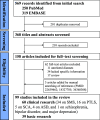Retinoic Acid-Induced 1 Gene and Neuropsychiatric Diseases: A Systematic Review
- PMID: 40437981
- PMCID: PMC12133160
- DOI: 10.1017/erm.2025.12
Retinoic Acid-Induced 1 Gene and Neuropsychiatric Diseases: A Systematic Review
Abstract
Background: Retinoic acid-induced 1 (RAI1) is a dosage-sensitive gene implicated in a range of rare neuropsychiatric diseases.
Methods: This review provides a comprehensive overview of RAI1's role, integrating both clinical and basic research on Smith-Magenis syndrome (SMS) and Potocki-Lupski syndrome (PTLS) while also summarising research progress on its involvement in spinocerebellar ataxia (SCA), autism spectrum disorder (ASD), schizophrenia, bipolar disorder and major depression. A systematic review of the literature was conducted using PubMed and EMBASE, following the PRISMA guidelines, with the protocol registered in PROSPERO (CRD42023474165).
Results: A total of 99 eligible studies on RAI1 were included. We presented detailed characterisations of SMS and PTLS patients, emphasising the crucial role of RAI1 haploinsufficiency and overexpression in their pathogenesis. Additionally, we summarised research progress on RAI1 in SCA, ASD, schizophrenia, bipolar disorder and major depression. Integrating findings from animal studies, particularly those examining the regulatory mechanisms of RAI1 in critical phenotypes, such as body weight, sleep and epilepsy, underscores the precise regulation of RAI1 expression in maintaining various nervous system functions.
Conclusions: Overall, this review contributes to the identification of RAI1-related neuropsychiatric diseases, with a particular emphasis on enhancing clinical diagnosis of SMS and PTLS in developing countries.
Keywords: Potocki–Lupski syndrome; RAI1; Smith–Magenis syndrome; neuropsychiatric diseases; retinoic acid-induced 1; systematic review.
Conflict of interest statement
The authors declare no competing interests.
Figures


Similar articles
-
Retinoic Acid Induced 1 and Smith-Magenis Syndrome: From Genetics to Biology and Possible Therapeutic Strategies.Int J Mol Sci. 2025 Jul 11;26(14):6667. doi: 10.3390/ijms26146667. Int J Mol Sci. 2025. PMID: 40724914 Free PMC article. Review.
-
Generation and characterization of the CSSi021-A (15665) human induced pluripotent stem cell line from a Smith-Magenis syndrome patient with a heterozygous RAI1 mutation.Stem Cell Res. 2025 Aug;86:103726. doi: 10.1016/j.scr.2025.103726. Epub 2025 Apr 26. Stem Cell Res. 2025. PMID: 40311325
-
Systemic pharmacological treatments for chronic plaque psoriasis: a network meta-analysis.Cochrane Database Syst Rev. 2021 Apr 19;4(4):CD011535. doi: 10.1002/14651858.CD011535.pub4. Cochrane Database Syst Rev. 2021. Update in: Cochrane Database Syst Rev. 2022 May 23;5:CD011535. doi: 10.1002/14651858.CD011535.pub5. PMID: 33871055 Free PMC article. Updated.
-
Shared decision-making interventions for people with mental health conditions.Cochrane Database Syst Rev. 2022 Nov 11;11(11):CD007297. doi: 10.1002/14651858.CD007297.pub3. Cochrane Database Syst Rev. 2022. PMID: 36367232 Free PMC article.
-
Signs and symptoms to determine if a patient presenting in primary care or hospital outpatient settings has COVID-19.Cochrane Database Syst Rev. 2022 May 20;5(5):CD013665. doi: 10.1002/14651858.CD013665.pub3. Cochrane Database Syst Rev. 2022. PMID: 35593186 Free PMC article.
References
-
- Potocki L, Bi W, Treadwell-Deering D, Carvalho CM, Eifert A, Friedman EM, Glaze D, Krull K, Lee JA, Lewis RA, Mendoza-Londono R, Robbins-Furman P, Shaw C, Shi X, Weissenberger G, Withers M, Yatsenko SA, Zackai EH, Stankiewicz P and Lupski JR (2007) Characterization of Potocki–Lupski syndrome (dup(17)(p11.2p11.2)) and delineation of a dosage-sensitive critical interval that can convey an autism phenotype. American Journal of Human Genetics 80(4), 633–649. 10.1086/512864. - DOI - PMC - PubMed
Publication types
MeSH terms
Substances
LinkOut - more resources
Full Text Sources
Medical
Miscellaneous

